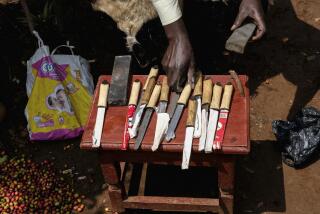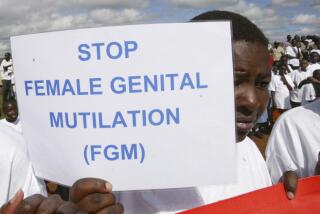A rebellion inside a small Indian sect seeks to end a brutal custom: female genital mutilation
Reporting from Mumbai, India — When she was 7, Saleha Paatwala’s grandmother took her out for what she thought would be a party.
“I was told it would be a huge gathering where kids like me would also be,” Paatwala said.
Instead she found herself in a dark, messy room where three other women were waiting. They pulled her down, held her hands and feet so she couldn’t move and slipped off her underwear as she screamed.
A tall woman spread Paatwala’s legs, grabbed a blade and made a cut. She placed some cotton at the spot of the incision, but the pain lingered. She could not urinate comfortably for three days. Paatwala had undergone a crude procedure to remove her clitoris, a risky practice that has been outlawed in much of the world, but is not explicitly illegal in India. It remains common among the Dawoodi Bohras, a small Muslim sect.
Now 23, Paatwala has joined a growing movement inside the 1 million-strong Bohra community to fight the practice it calls khatna, known worldwide as female genital mutilation, or FGM.
Bohra Muslims as far away as Australia and the United States are also speaking out against a custom that for centuries has been carried out mostly in secret. In recent months, documentary films, advocacy campaigns and an online petition garnering more than 50,000 signatures have shed light on the practice.
Paatwala, who said she felt “betrayed” by her family, began speaking out against khatna last year and was surprised to find out that her mother opposed it, too.
“She was too afraid to go against her own mother, and so she supported her decision to get us cut,” said Paatwala, who works at a marketing agency in New Delhi. “My parents’ support gives me more power to fight against this barbaric practice.”
The World Health Organization estimates that more than 200 million girls and women have undergone FGM in 30 countries in Africa, the Middle East and Asia. It defines FGM as any procedure that partially or fully removes the female genitalia for non-medical reasons, and says it is “recognized internationally as a violation of the human rights of girls and women.”
After the U.N. General Assembly passed a resolution in 2012 to eradicate FGM globally, several countries instituted laws against the practice. India has not imposed a ban, although activists say existing legislation covering sexual assault and crimes against children could be applied to curb the practice, also known as female circumcision.
The rebellion has sharply divided the Bohras, a Shiite Muslim sect that originated in Yemen. The largest Bohra community today lives in western India, their ancestors having arrived here in the 16th century after fleeing persecution from Sunnis.
In cities like Mumbai they became traders and prospered financially while projecting an educated, generally progressive image. Many Bohra women hold jobs. Yet traditionalists maintain that khatna is their religious right.
While the Koran, the Muslim holy book, does not sanction female circumcision, Daimul Islam, a religious text followed by Bohras, endorses the practice for hygienic reasons. Some Bohras also believe it enhances a woman’s complexion, controls her sexual urges and makes her more devout.
There was a time when this brutal practice was India’s best kept secret.
— Insia Dariwala, Bohra activist and filmmaker
Saifuddin Insaf, editor of the Bohra Chronicle, a reformist newsletter published in Mumbai, where the community has its headquarters, said khatna historically was seen as a way for Bohra merchants and traders to “subdue their wives’ sexual desire” while the husband was away on business.
These days, Insaf said, “it’s done in a most secretive way. The women performing the cut do not have proper training. There is no anesthesia. The girls suffer later on in life. There have been deaths.”
In February, religious leaders in three Bohra communities overseas – in Sydney and Melbourne, Australia, and London – issued letters urging their faithful not to circumcise girls because it would violate local laws.
But this week, the Bohras’ supreme leader, or syedna, Mufaddal Saifuddin, said male and female circumcision were “religious rites that have been practiced by Dawoodi Bohras throughout their history.”
In a statement from Mumbai, Saifuddin said that while Bohras should not contravene laws where they live, “religious books, written over 1,000 years ago, specify the requirements for both males and females as acts of religious purity.”
In response, Sahiyo, a group of anti-khatna activists, said: “We are one community, and we are disappointed that Bohra girls in some parts of the world are still expected to be cut.”
Sahiyo was formed last year by five Bohra women in India and abroad to create greater awareness about the procedure, which is usually carried out on girls around age 7.
“It was difficult to get people together who were willing to reveal their identities and speak out against the practice,” said cofounder Priya Goswami, a documentary filmmaker from New Delhi whose 2013 short film on khatna, “A Pinch of Skin,” was honored at India’s National Film Awards.
“But as we came together, somehow people were open about showing their support.”
Cofounder Mariya Taher, who was raised in San Francisco, was circumcised at age 7 during a visit to Mumbai. As a graduate student at San Francisco State University, Taher studied FGM in the United States and found that Bohra immigrants continued the practice as a way to “hold on to cultural roots,” she said.
The group’s efforts have sometimes met with resistance – particularly online, where commenters on its website have accused the organization of going against the Koran, disrespecting the syedna or having “a devil-infected mind.”
“I think we all knew backlash would come and we prepared ourselves as best as we could,” said Taher, who now lives in Boston. “What helps us go through it is that we have the support of each other.”
The debate comes amid a schism in the Bohra community that dates to 2014, when the death of the former syedna sparked a succession dispute. The leader of a small breakaway faction, Taher Fakhruddin, has said circumcision should only be done with a female’s consent, but activists say young girls are ill prepared to make such choices.
Sahiyo’s founders say the movement has support from all segments of Bohra society, and hope the pressure will force action from India’s government.
“There was a time when this brutal practice was India’s best kept secret. Today, too, it is in some ways,” said Insia Dariwala, a Mumbai filmmaker and Sahiyo cofounder. “But in the past six months, we have made enough noise for the concerned departments to sit up and take notice.”
Parth M.N. is a special correspondent.
ALSO
Mass shooting at gay nightclub in Orlando results in ‘mass casualties’
Spate of shootings in L.A. County leaves at least 7 dead and 5 wounded
Meet one of Hillary Clinton’s biggest donors in California. They hardly ever talk politics
Follow @SBengali on Twitter for more news from South Asia
More to Read
Sign up for Essential California
The most important California stories and recommendations in your inbox every morning.
You may occasionally receive promotional content from the Los Angeles Times.











